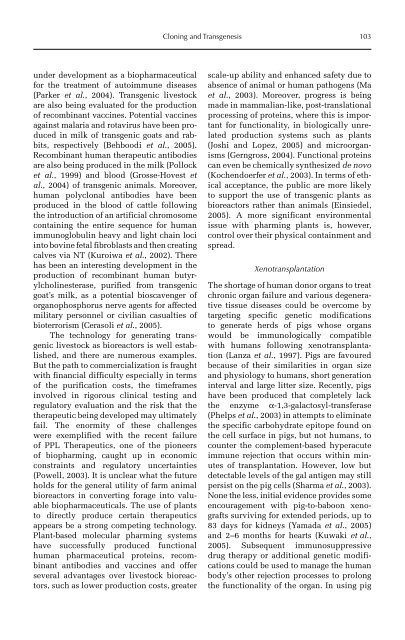Redesigning Animal Agriculture
Redesigning Animal Agriculture
Redesigning Animal Agriculture
Create successful ePaper yourself
Turn your PDF publications into a flip-book with our unique Google optimized e-Paper software.
under development as a biopharmaceutical<br />
for the treatment of autoimmune diseases<br />
(Parker et al., 2004). Transgenic livestock<br />
are also being evaluated for the production<br />
of recombinant vaccines. Potential vaccines<br />
against malaria and rotavirus have been produced<br />
in milk of transgenic goats and rabbits,<br />
respectively (Behboodi et al., 2005).<br />
Recombinant human therapeutic antibodies<br />
are also being produced in the milk (Pollock<br />
et al., 1999) and blood (Grosse-Hovest et<br />
al., 2004) of transgenic animals. Moreover,<br />
human polyclonal antibodies have been<br />
produced in the blood of cattle following<br />
the introduction of an artificial chromosome<br />
containing the entire sequence for human<br />
immunoglobulin heavy and light chain loci<br />
into bovine fetal fibroblasts and then creating<br />
calves via NT (Kuroiwa et al., 2002). There<br />
has been an interesting development in the<br />
production of recombinant human butyrylcholinesterase,<br />
purified from transgenic<br />
goat’s milk, as a potential bioscavenger of<br />
organophosphorus nerve agents for affected<br />
military personnel or civilian casualties of<br />
bioterrorism (Cerasoli et al., 2005).<br />
The technology for generating transgenic<br />
livestock as bioreactors is well established,<br />
and there are numerous examples.<br />
But the path to commercialization is fraught<br />
with financial difficulty especially in terms<br />
of the purification costs, the timeframes<br />
involved in rigorous clinical testing and<br />
regulatory evaluation and the risk that the<br />
therapeutic being developed may ultimately<br />
fail. The enormity of these challenges<br />
were exemplified with the recent failure<br />
of PPL Therapeutics, one of the pioneers<br />
of biopharming, caught up in economic<br />
constraints and regulatory uncertainties<br />
(Powell, 2003). It is unclear what the future<br />
holds for the general utility of farm animal<br />
bioreactors in converting forage into valuable<br />
biopharmaceuticals. The use of plants<br />
to directly produce certain therapeutics<br />
appears be a strong competing technology.<br />
Plant-based molecular pharming systems<br />
have successfully produced functional<br />
human pharmaceutical proteins, recombinant<br />
antibodies and vaccines and offer<br />
several advantages over livestock bioreactors,<br />
such as lower production costs, greater<br />
Cloning and Transgenesis 103<br />
scale-up ability and enhanced safety due to<br />
absence of animal or human pathogens (Ma<br />
et al., 2003). Moreover, progress is being<br />
made in mammalian-like, post- translational<br />
processing of proteins, where this is important<br />
for functionality, in biologic ally unrelated<br />
production systems such as plants<br />
(Joshi and Lopez, 2005) and microorganisms<br />
(Gerngross, 2004). Functional proteins<br />
can even be chemically synthesized de novo<br />
(Kochendoerfer et al., 2003). In terms of ethical<br />
acceptance, the public are more likely<br />
to support the use of transgenic plants as<br />
bioreactors rather than animals (Einsiedel,<br />
2005). A more significant environmental<br />
issue with pharming plants is, however,<br />
control over their physical containment and<br />
spread.<br />
Xenotransplantation<br />
The shortage of human donor organs to treat<br />
chronic organ failure and various degenerative<br />
tissue diseases could be overcome by<br />
targeting specific genetic modifications<br />
to generate herds of pigs whose organs<br />
would be immunologically compatible<br />
with humans following xenotransplantation<br />
(Lanza et al., 1997). Pigs are favoured<br />
because of their similarities in organ size<br />
and physiology to humans, short generation<br />
interval and large litter size. Recently, pigs<br />
have been produced that completely lack<br />
the enzyme α-1,3-galactosyl-transferase<br />
(Phelps et al., 2003) in attempts to eliminate<br />
the specific carbohydrate epitope found on<br />
the cell surface in pigs, but not humans, to<br />
counter the complement-based hyperacute<br />
immune rejection that occurs within minutes<br />
of transplantation. However, low but<br />
detectable levels of the gal antigen may still<br />
persist on the pig cells (Sharma et al., 2003).<br />
None the less, initial evidence provides some<br />
encouragement with pig-to-baboon xenografts<br />
surviving for extended periods, up to<br />
83 days for kidneys (Yamada et al., 2005)<br />
and 2–6 months for hearts (Kuwaki et al.,<br />
2005). Subsequent immunosuppressive<br />
drug therapy or additional genetic modifications<br />
could be used to manage the human<br />
body’s other rejection processes to prolong<br />
the functionality of the organ. In using pig










